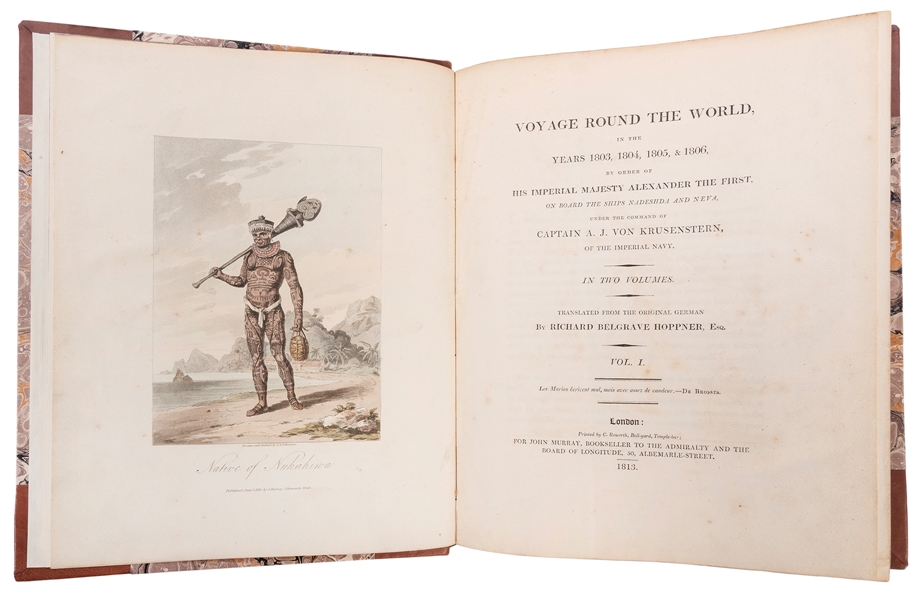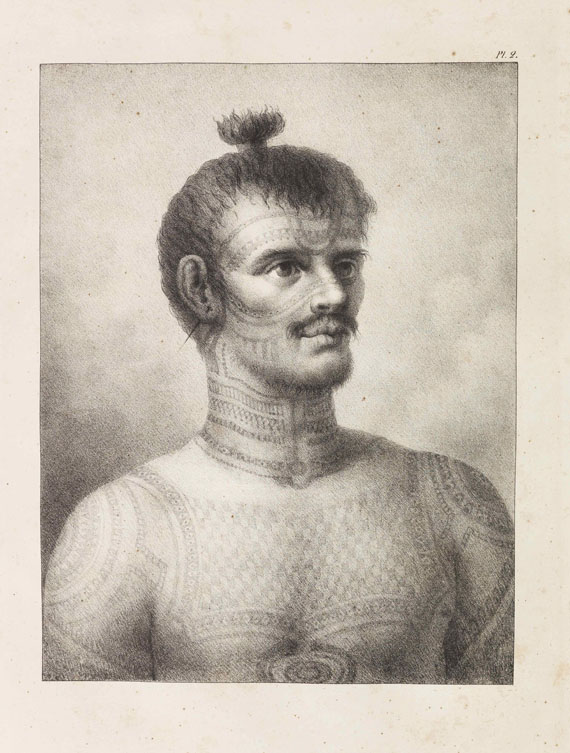Krusenstern, Adam Johann vonVoyage autour du monde, fait dans les annees 1803, 1804, 1805 et 1806, par les ordres de Sa Majestie Imperiale Alexandre Ier, empereur de Russie, sur les vaisseaux la Nadiejeda et la Neva. Paris: Gide fils, 1821
3 vols. Text: 2 vols., 8vo (203 x 140 mm). Gray paper boards; rebacked. Atlas: folio (470 x 305 mm). 30 engraved plates including portrait, 9 maps and 20 plates, and 2 double-page maps. Bound to style in gray paper boards. First French edition, with the very rare atlas not published with the English edition. This is the first Russian circumnavigation, written by its commander, and of great importance to Pacific history for his account of the attempt to open Japan to commerce, and for Krusenstern's notes on the Russian-Chinese trade. The two ships sailed from Kronstadt on 19 July 1803, and were together until the Marquesas and Hawaii. They visited Hawaii in the summer of 1804, touching briefly on the Big Island to trade for needed supplies. From there Krusenstern sailed by himself for Kamchatka, where he made extensive surveys and ethnographic inquiries. Japan was the main focus of the expedition. They arrived at Nagasaki on 30 August 1804, with the emissary from the Tsar, and presents, including looking glasses and a portrait of Catherine the Great. Hoping to open a trade mission, and expecting more freedom than was granted the Dutch, they found themselves "greatly mistaken." They were kept in confinement and suspense, and at the audience the following April, the negotiations collapsed. The ships' repairs were put to the Imperial account, all gifts were sent back, and they were politely but firmly asked not to return.
The narrative contains a detailed account of the negotiations and includes a view of Nagasaki Harbor, one of the first views of Japan published in the west. Krusenstern charted much of the west coast of Japan, made a short stop at Hokkaido, and at Aniwa Bay, and gives an account of his contact with Ainu people. The fine atlas is illustrated with twenty-one lithographic plates by Engelmann and nine engraved maps (three folding). Though unsigned, O'Reilly says the plates are probably the work of Tilesius, one of the naturalists of the ship. They include a portrait of Krusenstern, four views of Nukuhiwa and eight of Japan (including the Ainus). The maps include three of the Marquesas and four of Japanese interest. "The atlas volume is very important and is difficult to obtain" (Hill). The work was translated and revised by J.B.B. Eyries, who also wrote part of the text for Choris's "Voyage Pittoresque." REFERENCE:Forbes Hawaii 530; Hill 167-68; O'Reilly & Reitman 732, 695; Sabin 38382
Krusenstern, Adam Johann vonVoyage autour du monde, fait dans les annees 1803, 1804, 1805 et 1806, par les ordres de Sa Majestie Imperiale Alexandre Ier, empereur de Russie, sur les vaisseaux la Nadiejeda et la Neva. Paris: Gide fils, 1821
3 vols. Text: 2 vols., 8vo (203 x 140 mm). Gray paper boards; rebacked. Atlas: folio (470 x 305 mm). 30 engraved plates including portrait, 9 maps and 20 plates, and 2 double-page maps. Bound to style in gray paper boards. First French edition, with the very rare atlas not published with the English edition. This is the first Russian circumnavigation, written by its commander, and of great importance to Pacific history for his account of the attempt to open Japan to commerce, and for Krusenstern's notes on the Russian-Chinese trade. The two ships sailed from Kronstadt on 19 July 1803, and were together until the Marquesas and Hawaii. They visited Hawaii in the summer of 1804, touching briefly on the Big Island to trade for needed supplies. From there Krusenstern sailed by himself for Kamchatka, where he made extensive surveys and ethnographic inquiries. Japan was the main focus of the expedition. They arrived at Nagasaki on 30 August 1804, with the emissary from the Tsar, and presents, including looking glasses and a portrait of Catherine the Great. Hoping to open a trade mission, and expecting more freedom than was granted the Dutch, they found themselves "greatly mistaken." They were kept in confinement and suspense, and at the audience the following April, the negotiations collapsed. The ships' repairs were put to the Imperial account, all gifts were sent back, and they were politely but firmly asked not to return.
The narrative contains a detailed account of the negotiations and includes a view of Nagasaki Harbor, one of the first views of Japan published in the west. Krusenstern charted much of the west coast of Japan, made a short stop at Hokkaido, and at Aniwa Bay, and gives an account of his contact with Ainu people. The fine atlas is illustrated with twenty-one lithographic plates by Engelmann and nine engraved maps (three folding). Though unsigned, O'Reilly says the plates are probably the work of Tilesius, one of the naturalists of the ship. They include a portrait of Krusenstern, four views of Nukuhiwa and eight of Japan (including the Ainus). The maps include three of the Marquesas and four of Japanese interest. "The atlas volume is very important and is difficult to obtain" (Hill). The work was translated and revised by J.B.B. Eyries, who also wrote part of the text for Choris's "Voyage Pittoresque." REFERENCE:Forbes Hawaii 530; Hill 167-68; O'Reilly & Reitman 732, 695; Sabin 38382















Testen Sie LotSearch und seine Premium-Features 7 Tage - ohne Kosten!
Lassen Sie sich automatisch über neue Objekte in kommenden Auktionen benachrichtigen.
Suchauftrag anlegen